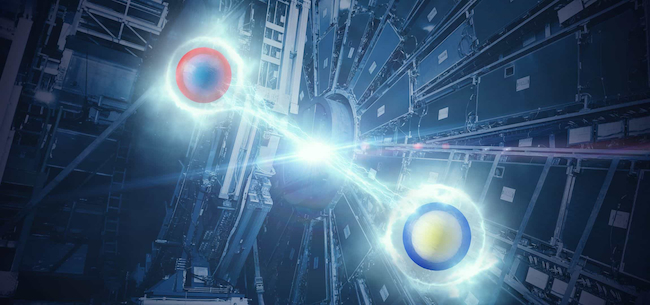UofG physicists play key roles in new observation of quantum entanglement at the highest energy yet
Published: 19 September 2024
Researchers from the School of Physics & Astronomy have played a leading role in an experiment which has opened up a new perspective on the complex world of quantum physics using data from the Large Hadron Collider (LHC).
Researchers from the University of Glasgow’s School of Physics & Astronomy have played a leading role in an experiment which has opened up a new perspective on the complex world of quantum physics using data from the Large Hadron Collider (LHC).
ATLAS is a general-purpose particle detector at CERN’s LHC in Geneva. Physicists from the University of Glasgow have played key roles in the international ATLAS collaboration for decades.
Quantum entanglement is a fascinating feature of quantum physics – the theory of the very small. If two particles are quantum-entangled, the state of one particle is tied to that of the other, no matter how far apart the particles are.
This mind-bending phenomenon, which has no analogue in classical physics, has been observed in a wide variety of systems and has found several important applications, such as quantum cryptography and quantum computing but has remained largely unexplored at the high energies accessible at particle colliders such as the LHC.
ATLAS captures data from particles produced during the high-energy collisions of protons in the LHC. Analysis of the data helps to deepen our understanding of the fundamental nature of matter and the basic forces that shape our universe.

One of the particles produced during those collisions, the top quark, is the heaviest known fundamental particle, and one of the most short-lived. The top quark normally decays into other particles before it has time to combine with other quarks, transferring its spin and other quantum traits to its decay particles. Physicists observe and use these decay products to infer the top quark's spin orientation.
New research from the ATLAS experiment, published in Nature, reports the observation of quantum entanglement at the LHC for the first time, between fundamental particles called top quarks and at the highest energies yet explored.
The University of Glasgow’s Dr James Howarth and Dr Yoav Afik, from the University of Chicago, led the experimental effort for this research.
Dr Howarth is Royal Society University Research Fellow and Senior Lecturer at the School of Physics & Astronomy. He said: “The LHC has long relied on the lessons of quantum mechanics to study the fundamental forces and particles of nature, but this is the first time we have really tested the truly fundamental quantum nature of reality itself. Research like this is an incredibly new idea for particle colliders and, with this first observation, we have shown that it is possible to use colliders in a whole new way.”
Dr Ethan Simpson, who is now a post-doctoral researcher at the University of Manchester, worked on the research during his PhD at the University of Glasgow, for which he received the Kelvin Medal and Prize. He said: “This measurement is exciting because it constitutes the highest energy measurement of quantum entanglement we've ever made in a lab. At the start of my PhD, we didn't know that entanglement was a phenomenon you could measure using the ATLAS detector, so it was great to be part of the team which made this novel measurement: it has opened the floodgates for many new proposed measurements, all designed to test quantum mechanics at the LHC.”
This research is supported by the Science and Technology Facilities Council (STFC) and the Royal Society.
First published: 19 September 2024

